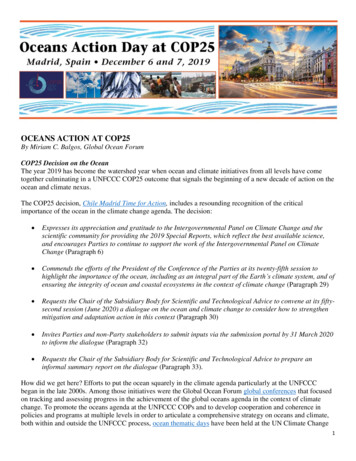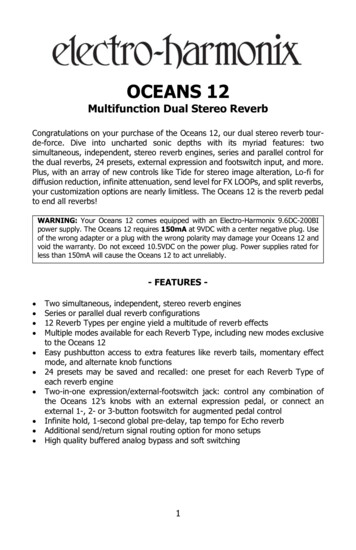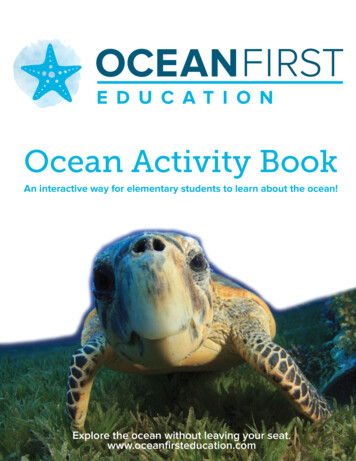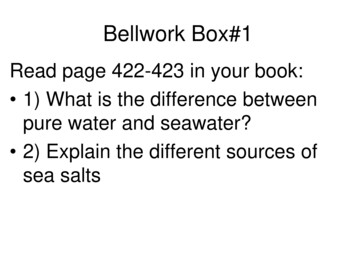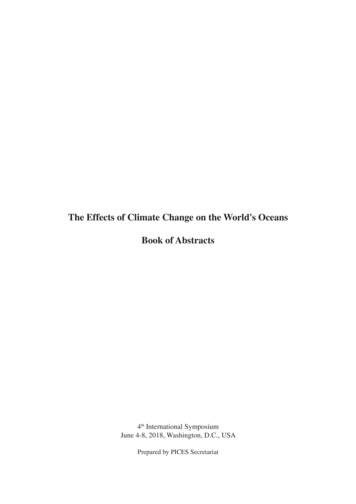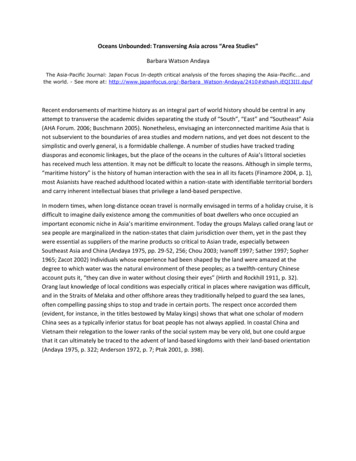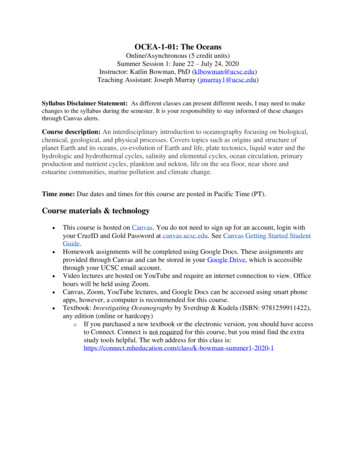
Transcription
OCEA-1-01: The OceansOnline/Asynchronous (5 credit units)Summer Session 1: June 22 – July 24, 2020Instructor: Katlin Bowman, PhD (klbowman@ucsc.edu)Teaching Assistant: Joseph Murray (jmurray1@ucsc.edu)Syllabus Disclaimer Statement: As different classes can present different needs, I may need to makechanges to the syllabus during the semester. It is your responsibility to stay informed of these changesthrough Canvas alerts.Course description: An interdisciplinary introduction to oceanography focusing on biological,chemical, geological, and physical processes. Covers topics such as origins and structure ofplanet Earth and its oceans, co-evolution of Earth and life, plate tectonics, liquid water and thehydrologic and hydrothermal cycles, salinity and elemental cycles, ocean circulation, primaryproduction and nutrient cycles, plankton and nekton, life on the sea floor, near shore andestuarine communities, marine pollution and climate change.Time zone: Due dates and times for this course are posted in Pacific Time (PT).Course materials & technology This course is hosted on Canvas. You do not need to sign up for an account, login withyour CruzID and Gold Password at canvas.ucsc.edu. See Canvas Getting Started StudentGuide.Homework assignments will be completed using Google Docs. These assignments areprovided through Canvas and can be stored in your Google Drive, which is accessiblethrough your UCSC email account.Video lectures are hosted on YouTube and require an internet connection to view. Officehours will be held using Zoom.Canvas, Zoom, YouTube lectures, and Google Docs can be accessed using smart phoneapps, however, a computer is recommended for this course.Textbook: Investigating Oceanography by Sverdrup & Kudela (ISBN: 9781259911422),any edition (online or hardcopy)o If you purchased a new textbook or the electronic version, you should have accessto Connect. Connect is not required for this course, but you mind find the extrastudy tools helpful. The web address for this class summer1-2020-1
Course designMaterials for this course are organized by week. Each week contains reading quizzes, videolectures, and an assessment (homework assignment or exam).Reading quizzes: Each week will cover 2–4 chapters from your textbook. Reading assignmentsprovide your first introduction to new topics covered in the course. At a minimum, you shouldskim through each chapter, paying close attention to graphics and diagrams. Reading quizzes areworth 15 points each and can be taken up to three times (your highest score will be recorded).You should have your textbook open and in front of you while taking reading quizzes. Thesequizzes are not designed to test your knowledge of new material, they are designed to strengthenyour understanding of the text.Video lectures: Each week includes 2–4 video lectures (40–60 minutes in length) thatcompliment reading assignments. Video lectures are hosted on YouTube (closed captioningavailable), you will need a good internet connection to watch. If you have questions during thevideo lectures (or during reading assignments), use the Discussion board for that week inCanvas.Assessments: Each week includes one assessment (homework assignment or exam) that shouldbe completed after watching video lectures and taking reading quizzes. The assessment forweeks 1, 2, and 4 is a homework assignment, provided as a Google Doc in Canvas. Eachhomework assignment is worth 30 points. The assessment for weeks 3 and 5 is an exam,provided as a quiz in Canvas. Each exam is worth 200 points. Once you begin taking the exam,you will have three hours to complete. You cannot complete part of the exam and finish later,and you must work alone. You may use your textbook, lecture slides, and notes during the exam.Plagiarism (i.e. copy and pasting answering from the internet) and copying answers from yourclassmates will not be tolerated. I am required to report instances of plagiarism to UCSC and youwill receive a 0 on the exam (more information below under “Academic Dishonesty”). Unlikereading quizzes, you will only have one opportunity to take each exam.Due dates: Assignment due dates are listed in the schedule below, and posted in the coursecalendar on Canvas. If you miss a due date, please reach out to me through email immediately.Extensions may be granted for extenuating circumstances.
ScheduleWeekReading QuizzesVideo LecturesAssessments1Chapters 1-3Lectures 1-3due Friday June 26 by 11:59 PMHomework 1due Sunday June 28 by 11:59 PM2Chapters 4-7due Friday July 3 by 11:59 PMLectures 4-6Homework 2due Sunday July 5 by 11:59 PM3Chapters 8-10due Friday July 10 by 11:59 PMLectures 7 & 8Exam 1 (Chapters 1-9)due Sunday July 12 by 11:59 PM4Chapters 11-14due Friday July 17 by 11:59 PMLectures 9-12Homework 3due Sunday July 19 by 11:59 PM5Chapters 15 & 16due Friday July 24 by 11:59 PMLectures 13 & 14Exam 2 (Chapters 10-16)due Friday July 24 by 11:59 PMGrading240 points90 points400 points730 pointsReading quizzesHomework assignmentsExamsTotal points.Letter gradeABCDFPoints earned (%)90–10080–8970–7960–69 60Important Summer Session Remote 2020 DeadlinesDrop: Monday, June 29Request for “W”: Friday, July 10Summer is unique. You will not be dropped for non-attendance or non-payment. Youmust drop yourself. Dropping before the deadline results in a full-tuition reversal/refund.Withdraw posts a W for the grade and full tuition is charged (no refund).For all dates and deadlines, including ‘change of grade option’ (P/NP) and grades due, here is thesummer academic calendar: https://summer.ucsc.edu/studentlife/index.htmlFor questions about dropping, requesting a W grade for a course, or withdrawing from thesummer quarter, email summer@ucsc.edu.
CommunicationDuring this course we will communicate primarily through Canvas discussion boards and Zoomoffice hours, with some email communication. Please sign up for Canvas notifications and checkyour email frequently to stay informed. I will post announcements on Canvas every Monday to remind you of due dates for theweek, and to provide any new updates.The following discussion boards are available through Canvas. Posting in discussionboards is recommended, but not required for this course.o Weekly discussion boards: Each week has a discussion board where you canpost questions about the material (reading and lecture videos). Browse throughquestions posted by your classmates and ask new questions here. I will respond toquestions within 24 hours Monday–Friday.o General questions: Post general questions about the course here (i.e., When ishomework 1 due? How can I view my grade in Canvas?). This discussion boardincludes a link to a FAQ (Facts and Questions) document to further assist withgeneral questions about the course.o Let’s work together: Use this discussion board to connect with your classmates.You are welcome to work with other students on homework assignments, andvirtual study groups may be helpful to prepare for exams.o Icebreaker: Virtual learning can be lonely! This discussion board provides aspace for us to get to know each and stay connect throughout the summer session.Office hoursKatlin is available for office hours through Zoom, every Friday from 9:00 AM to 12:00 PM, orby appointment. Email me directly through Canvas or at klbowman@ucsc.eduLink to join office hours(same link each week):https://ucsc.zoom.us/j/97814276996?pwd dXZEaG9oZ2xKWlVzaXE2a0cwTXhoQT09Password: bananaslug
Student Learning OutcomesWeek 1: Earth science (Chapters 1–3) Draw connections between the physical geology of Earth, plate tectonics, coastalfeatures, and ocean basins. Identify seafloor features, and the geological processes that create islands, deep-seahydrothermal vents and trenches.Week 2: Water properties, air and water circulation (Chapters 4–7) Demonstrate an understanding of specific and latent heat, and changes of state. Explain global variations in surface seawater salinity. Write the chemical equations for photosynthesis and respiration. Conceptualize patterns air circulation cells and prevailing wind patterns across the globe.Week 3: Waves, tides, and coastal habitats (Chapters 8-10) Label parts of a wave and distinguish between different wave types, generating, andrestoring forces. Explain processes that create tides and characterize different tidal patterns. Characterize coastal habitats, and features belonging to depositional and erosional coasts.Week 4: Life in the ocean (Chapters 11-14) Organize marine organisms into groups using taxonomy (domain and phylum), habitat,metabolism, and lifestyle classifications. Explain the evolution of life in the ocean, and its significance to the evolution of life onEarth. Identify trophic levels and explain energy transfer within marine food chains. Describe interspecific competition between marine organisms.Week 5: Marine pollution and climate change (Chapters 15-16) Distinguish between natural and anthropogenic climate variations. Explain how climate change impacts marine habitats and contributes to sea level rise. Identify sources of marine pollution and threats of marine pollution.
Student resourcesDRC Remote Accommodations: The Disability Resources Center reduces barriers to inclusionand full participation for students with disabilities by providing support to individually determinereasonable academic accommodations. Operations continue via remote appointments. If youhave questions or concerns about exam accommodations or any other disability-related matter,email the DRC Schedulers at drc@ucsc.edu for an appointment.Small Group Tutoring: Small Group Tutoring (SGT) supports students academically toadvance educational equity by designing inclusive learning environments outside of theclassroom. In SGT, you can expect the Tutor to facilitate cooperative group activities designed tohave students work together on the course content and develop study skills for the course. SGT isoffered at least three times each week for the entire quarter. The Tutor is an undergraduatestudent who took the class, did well, and is trained to facilitate group sessions to focus onstudents’ needs to succeed in the course. SGT is open to all students enrolled in the class andthey must sign up on our online system: TutorTrac. When students sign up for SGT, they arecommitting to attend every week. For Summer 2020, students can begin signing up for tutoringon Monday, June 22rd and tutoring will begin Wednesday, June 24th. Students only have tosign up once for tutoring and their appointments will repeat weekly. Sign-ups will close onFriday, August 14th for all Summer Session Sign-Ups. This means that after August 14th, nonew students can sign up for tutoring.Want SGT to be successful for you? Bring your books, lecture notes, questions, and be open toworking collaboratively with your peers. You can sign up using this link: errText insufficient%20credentials%20to%20view%20content You can also find the link on our website: https://lss.ucsc.edu/index.htmlAcademic Dishonesty: Academic integrity is the cornerstone of a university education.Academic dishonesty diminishes the university as an institution and all members of theuniversity community. It tarnishes the value of a UCSC degree. All members of the UCSCcommunity have an explicit responsibility to foster an environment of trust, honesty, fairness,respect, and responsibility. All members of the university community are expected to present astheir original work only that which is truly their own. All members of the community areexpected to report observed instances of cheating, plagiarism, and other forms of academicdishonesty in order to ensure that the integrity of scholarship is valued and preserved at UCSC.In the event a student is found in violation of the UCSC Academic Integrity policy, he or shemay face both academic sanctions imposed by the instructor of record and disciplinary sanctionsimposed either by the provost of his or her college or the Academic Tribunal convened to hearthe case. Violations of the Academic Integrity policy can result in dismissal from the universityand a permanent notation on a student’s transcript. For the full policy and disciplinaryprocedures on academic dishonesty, students and instructors should refer to the AcademicIntegrity page at the Division of Undergraduate Education.
Title IX: The university cherishes the free and open exchange of ideas and enlargement ofknowledge. To maintain this freedom and openness requires objectivity, mutual trust, andconfidence; it requires the absence of coercion, intimidation, or exploitation. The principalresponsibility for maintaining these conditions must rest upon those members of the universitycommunity who exercise most authority and leadership: faculty, managers, and supervisors.The university has therefore instituted a number of measures designed to protect its communityfrom sex discrimination, sexual harassment, sexual violence, and other related prohibitedconduct. Information about the Title IX Office, the online reporting link, applicable campusresources, reporting responsibilities, the UC Policy on Sexual Violence and Sexual Harassment,and the UC Santa Cruz Procedures for Reporting and Responding to Reports of Sexual Violenceand Sexual Harassment can be found at titleix.ucsc.edu.The Title IX Office is actively responding to reports and requests for consultation. If you are notcurrently working with someone in the office and want to make a report/request a consult, youcan expect the fastest response by using our online reporting link. For more information pleasevisit the Title IX Operations under Covid-19 page.Tips for Success:1.2.3.4.5.6.7.8.Read the text –scan the figures and read captions.Practice effective note taking (study “Ten tips for taking good class notes” below).Ask questions on Canvas discussion boards and during office hours.Do not copy answers from your classmates on homework assignments, make sure youcan do all calculations on your own.Link or copy the Canvas calendar to your own calendar to remember important due dates.Check Canvas announcements and your email often for course reminders andannouncements.Attend office hours and come prepared with questions.Get a study network going with your fellow students.
Ten tips for taking good class notes1. Arrive to class early and settle in, warm up your mind. Review your current notes and askyour instructor for clarification where needed.2. Write your notes on paper rather than typing on a laptop. Typing notes may lead totranscribing the lecture, while writing notes requires that you conceptualize andsummarize information.3. Write your notes neatly so they are easy to study. Leave extra blank spaces (rather thancramming everything into a small space) so that you can go back and expand on topicslater.4. Scan your notes at the end of class for any illegible words, symbols, or sketches. Clarifythese errors before you leave class while the information is still fresh in your mind.5. Make key words and concepts stand out by highlighting, writing in a bold font, orunderlining.6. Pay extra attention to the most important points emphasized by your instructor. Thesewill be concepts that your instructor covers repeatedly or with extra emphasis (slowerpace, extra media, class participation).7. Sketch and doodle! Drawing is an excellent way to help visualize lecture material.8. Find the perfect writing tool. Having the right pen or pencil will make you more preparedto take effective class notes.9. Politely ask your instructor to slow down if your note taking cannot keep up the pace ofthe lecture.10. It is normal to lose focus or miss part of lecture – talk to your classmates during lecturebreaks or after class to help fill in the gaps.Adapted from: Nilson, L.B. 2016. Teaching at its best: A research-based resource for collegeinstructors (Fourth Edition). John Wiley & Sons, Inc., San Francisco, CA.
Online/Asynchronous (5 credit units) Summer Session 1: June 22 - July 24, 2020 Instructor: Katlin Bowman, PhD (klbowman@ucsc.edu) Teaching Assistant: Joseph Murray (jmurray1@ucsc.edu) Syllabus Disclaimer Statement: As different classes can present different needs, I may need to make changes to the syllabus during the semester.


